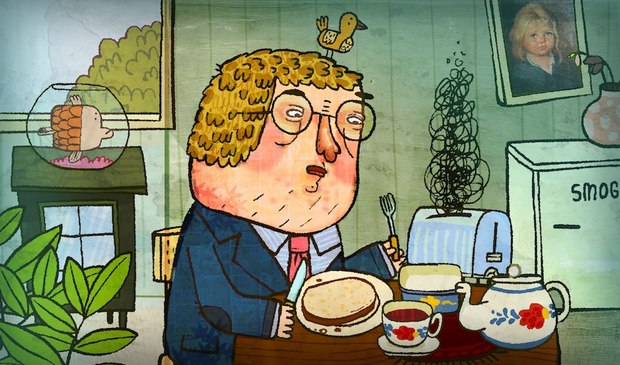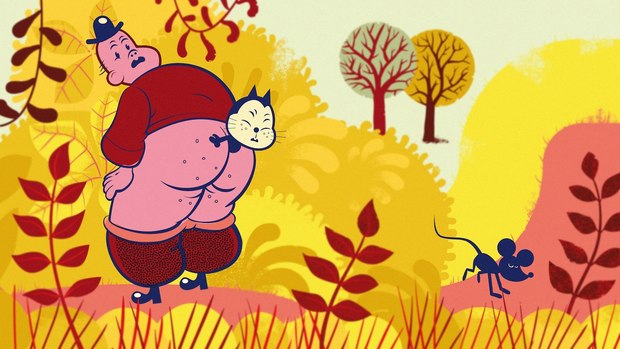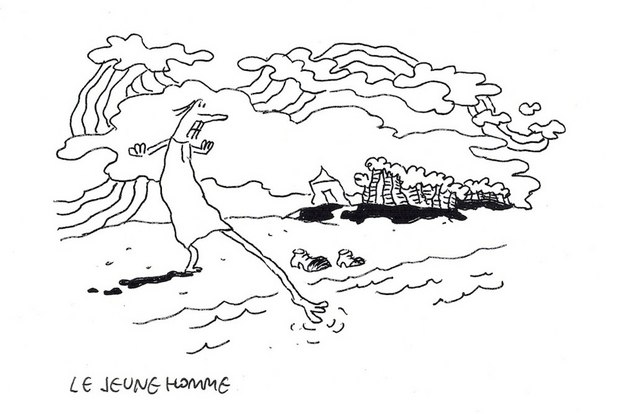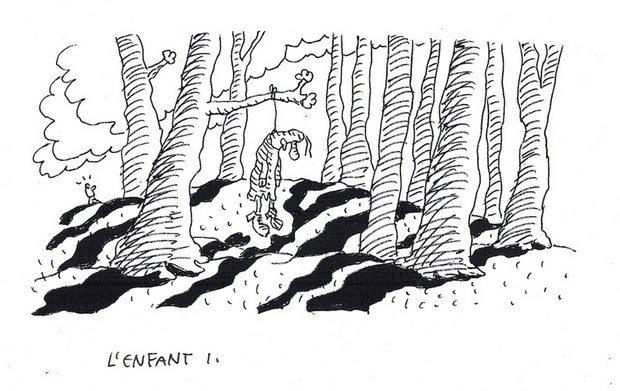Now in production in Paul Driessen's studio...
Paul Driessen is a self taught animator originally from the Netherlands. He animates with pencil and paper, often integrating his storyboards into the final imagery. He's best known for working on the Yellow Submarine (1968), and his personal films The Killing of an Egg (1977), The Boy Who Saw the Iceberg (2000), Oedipus (2011) and Cat Meets Dog (2015). He brings a quirky sense of humour, a touching feel for human experience, and a very animated cartoon-like line to his films.
Winning at least six awards at the Ottawa International Animation Festival over the years, I mostly recently caught up with Paul in Ottawa where his film Cat Meets Dog was in competition. We continued our conversation on email.
Sharon Katz: Paul, take us into your studio...
Paul Driessen: I'm just finishing a project called Disgusting Sounds People Make. We had an edit but it was not crazy enough so we had to redo it.
sk: In what way did you make Disgusting Sounds crazier in the new edit?
pd: We made it more tight, added what my editor calls a Hip-hop montage (some kind of very fast flash-back of the main action), exchanged a few of the gentler cartoons for weirder ones, made the sound more crazy. We’re still working on a stronger opening…
sk: Tell us a bit about it.
pd: For this project I wrote about 14 kinds of disgusting cartoons which a group of Belgian and Dutch animators then animated, each in their own style and technique. The cartoons are combined with a pixilated story (shot and directed by my co-director, Toon Loenders) of someone who looks for dirty sounds.
sk: Scatological?
pd: It’s sort of café humour, partly scatological. Not the kind of humour North Americans are too excited about as I discovered when I tried to arrange production in Canada. And most women I explained the premise to told me it’s for adolescents. Anyway, my group and I think it’s great fun.
sk: So who is the audience for this film?
pd: Well… mainly men of the European continent seem to go for it. Fortunately, that’s a lot of people. We had a small budget for this film but most animators didn’t care much about the money, they’d do it just for the fun of it. I told them, of course, that this would be one of the rare chances to do something really disgusting.
And I’m starting work on a new film called The Two Shoes, which is based on a Russian song from an old record of my parents. It's from the late 40’s when I was a kid living in Russia. We were fortunate to be able to enjoy some aspects of the rich Russian culture, especially its music. Sometimes we’d go to the Bolshoi Theater and hear the famous Red Army choir. The ballad I’m using for my film is sung by one of those beautiful voices with a choir singing the refrain; it’s a very sad song. I always wanted to do a film on it, and finally got my chance with a young French producer I met not so long ago. He was very intrigued and he’s coming to my place here in southern France to discuss the project further.
Meanwhile, I talked to Judith (Gruber Stitzer) about working on the song. The recording is very old and scratchy, which I kind of like, but she says it needs reworking. She even thinks of rerecording the whole thing with a new choir. Actually, there’s this large Russian community in New York, and also in Montreal, with really good choirs. Usually Russians can sing, they often have beautiful voices. If you ask the Dutch, nobody can sing.
sk: Canadians?
pd: Canadians fare a little better I would say. But Russians, they're natural singers…
sk: And dancers.
pd: And dancers of course. Have to get a little drunk, but they’ll do it. Anyway, I’m just starting this new project.
sk: A song has a beginning, middle, and end. What about this film?
pd: The same with this film…
sk: Will it be in sync with the music all the time, in terms of the story? The music going on in the background, and the film illustrating the song?
pd: No, not really. I wrote my own sad story, and in this case it doesn’t illustrate the text of the song at all, which is a bit of a problem. Mainly for Russian speaking people because they understand what the song is about and I’m not showing that. However, my story is also very sorrowful, so I figured that what I did per scene would kind of work with the sentiment of the verses of the song. It may even be convincing to Russians. They’ll cry with us…
sk: Tell us a bit about it.
pd: The song is about how at the time (and probably still now) many people were exiled to Siberia, usually for life, and sometimes they were allowed to bring their families with them because they would never return to their homes. Their wives and children and mothers might live in nearby towns and occasionally see their exiled sons. The song is about such a guy who is imprisoned in Siberia and his family is nearby, and he escapes and is on his way back to where he's from, except he will never make it because Siberia's so vaste.
sk: And cold.
pd: And cold.
sk: And dangerous.
pd: And dangerous, and all that.
sk: Do we know that he's never going to make it when we hear the music?
pd: Only if you speak Russian you would. The song has four verses and each verse has four lines and the last two sorrowful lines are repeated by the choir. The very last two lines of the song convey the typical Russian sentiment that the wife might remarry and pick up her life again, but his old mother will never see her son again. That’s the end of the original song and the end of my film. I wrote four stories to accompany the four verses, but my stories don’t follow the Russian text. It starts with the fateful story of a young boy; the next story pictures a young man, thereupon an adult, and finally an old man. Each one of my characters comes to a bad ending.
sk: It sounds so sad.
pd: It is sad but since it’s cartoon it’s treated more lightly. It’s basically the life of man ending badly.
sk: Do you think the music needs the words to make the film story understandable? …
pd: Maybe, maybe not. I tried something out before talking to Judith. I know the Russian text. I mean, I have it translated in Dutch and in English, so I know what the ballad is about. I rewrote the song in English with my own text to accompany my story. A Russian voice, or a voice with a Russian accent might sing it now in English.
I just did it as an exercise, it’s open to discussion. So we can either just do the original song the way it is or use my English text or do it in French (since I’m working with a French producer), or even translate my English text into Russian.
sk: What element inspired you to make this? That it’s from your childhood? From Russia?
pd: The song was my main inspiration. At first, however, I had written a light flimsy cartoon story, which was kind of interesting next to this heavy sorrowful song. Some people thought it was a little sexist though. It had to do with a rooster trying to seduce a chicken but it ends badly, both the rooster and the chicken ending up as roadkill. Anyway, I decided against it and replaced it with this more poetic ’shoe-story’.
In one of my little books called The Fiddle Fumble Stories there's a tale about two shoes taken on by a young man, then taken over by a middle aged man, and ends up with an old man who dies wearing them.
The film starts with a young boy walking through the forest barefoot. He sees a man wearing shiny shoes hanged from a tree. The boy wants the shiny shoes so he kicks the tree. The shoes fall off the body, he puts them on, and there's a chase scene which doesn't end well.
sk: This sounds terrifying.
pd: A young man then finds the shiny shoes and he also comes to a bad end. Next, they’re picked up by an adult who has just been robbed of all his clothes, who goes home only dressed in the two shoes. At home he discovers that his love has left him. He jumps out of the window, and the two shoes are left lying on the street below.
Finally an old man passes by, exchanges his old worn-out shoes for the two shiny ones, goes home, goes to sleep and dies of old age. The next morning the undertakers come and try to pull off the shoes, but they’re too tight and they can’t get them off. They bury the old man with the shoes… It’s about the four phases of life being lived and coming to a sad ending.
sk: Sad and scary really.
pd: My kind of thing.
sk: This is a cartoon memento mori, sort of twists the mind to think about it.
pd: Yeah. My producer liked its sentiment. I think it’s a good and touching story which will go nicely with the song.
sk: Poignant for sure, the opposite of the scatological film.
pd: Very different. The scatological film is fun but it won’t make you cry.
sk: The Two Shoes has direct storyline that is, of course, supported and well structured by the music. How do you know when to end the scatological one? I’m going to call it scatological because …
pd: It’s more crazy than scatological, I’d say. When I write my stories I usually already have an ending in mind. I'm a cartoonist. Cartoons always have some clue at the end, some kind of revelation, a little twist.
The ending of the scatological film is a little hard to explain since it has to do with the jumps from cartoon to pixilation. Briefly, a pixilated sound editor is attaching sounds from cartoons to live imagery. So in a scene where porridge is being dropped from a spoon onto a plate, the sound is... well a familiar nice splashing sound. It's a mashup of cartoon sounds and silent live footage.
sk: That's intriguing actually, usually we go with the opposite, cartoon imagery with foley.
pd: Yes, this is the other way around. Something bad happens to the man though. The situations he sets up for his live victims to add sound to get more and more unpleasant; in the end he falls into his own trap.
sk: So there's a story underpinning this film as well?
pd: Oh, certainly. I slowly built up the idea of how the film works, developing the pixilated story while injecting those different crazy cartoons done in different styles and techniques. This is the exciting part for me.
sk: Operating like your films which have multiple panels on the screen, like Cat Meets Dog? But with 14 different animators?
pd: Right. Maybe a bit fewer than 14 actually, some of them did more than one cartoon and I did two cartoons myself.
sk: How did you come to do this project?
pd: Two producers became interested in this project. One is a Dutch production company called il Luster. I've worked with them before. They’re very good, critical but very nice to work with. The other producer, Geert van Goethem, is Belgian. He and il Luster work often together. Geert is also a teacher, a very busy, very nice guy. I actually met him in Hiroshima, on the train to the festival.
Those things happen, you know, you go to festivals and you meet people....
Books and DVDs by and about Paul Driessen can be found on Amazon :
La Fin du chien-saucisse et autres petits contes
La Dernier oeuf de la dame dodo et autres petits contes
Animation Show of Shows - Volume 13
Animation Show of Shows - Box Set 3
Animation World of Paul Driessen (check for your country's format)
Animator Magazine #25 FN; Filmcraft comic book













